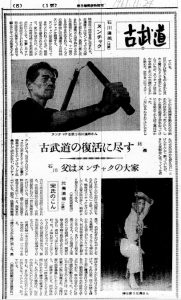Kobudō 7: Ishikawa Hōei and Higa Seitoku
November 24, 1961
Kobudo 7
Father, the Nunchaku Master
Ishikawa Hōei (50)
Nunchaku
Born in 1911 in Shuri into a family of martial artists—his father Hōkō was known as a master of nunchaku—Hōei grew familiar with kobujutsu from the time he was a child and began training in karate at the age of eleven. During the demonstration, he will perform the specialty of his father Hōko, the nunchaku.
The nunchaku is said to have come from China, but the weapon never gained much popularity before the war, making practitioners rare. The nunchaku has a wider range of use than the bō, and the ease of attack is said to be one of its advantages. Hōei took some kata of karate and modified them to create his own original nunchaku kata.
While karate was an intimate part of his life from childhood, Hōei didn’t begin using the nunchaku until he graduated from Nippon Sport Science University at the age of twenty-three. Since he’d already mastered karate by the time he began kobujutsu, it could be said Hōei was a late starter. However, his natural dexterity helped ensure his quick advancement after he began practicing.
“My father went easy on me, so I didn’t train hard. I’m not even half as proficient as he was,” Hōei humbly revealed, although he is clearly fired up about the coming demonstration. He spoke about the mindset required for one training with the nunchaku, saying “Just because attacking is easy doesn’t mean you can be reckless. The practitioner’s intention will determine whether the nunchaku becomes a weapon for self protection thus being useful or a deadly weapon.” Many young people began practicing nunchaku after the war, and the weapon is becoming more popular than it was before the war.
Dedication to the Revival of Kobudō
Higa Seitoku (41)
Soshi no Kon
Born in 1921 in Sueyoshi, Shuri. The President of the Kobudō Association, he is extremely passionate about reviving kobudō. “My love for martial arts is pure—it transcends styles. I hope to revive the kobudō of my hometown,” he said, sharing his ambitions. Currently Head of Civil Affairs at the Regional Legal Affairs Bureau, Seitoku wears glasses and has a kind appearance. You wouldn’t believe him if he told you he was a bō expert, but as soon as he puts his karate gi on and picks up his bō, he begins to exude intensity and a certain sharpness. When he performed the Soshi no Kon kata that he will show at the demonstration, the sounds of his bō slicing through the air and joints cracking rang out as he made his way around the entirety of the dojo. Perhaps this is what is meant by the phrase “kakure bushi,” or hidden warrior. Soshi no Kon is a Yamane-ryū basic kata and Seitoku learned it from the style’s creator, Chinen Masami.
The photograph shows a single frame of the Soshi no Kon kata in which the entire body is defended using a single bō.
He began learning the bō around the age of ten, starting with an introduction from his uncle, and for more than forty years since, he’s devoted himself completely to the weapon. While studying law at Chuo University in 1929, he gave frequent martial arts demonstrations, primarily at student association gatherings. During school breaks, he would read novels on Miyamoto Musashi for inspiration and travel all over Japan training diligently. “I would sleep out in the open or spend the night at a temple if it was raining. Sometimes I would train myself mentally by sitting under a waterfall. That kind of training was really advantageous for daily life too. It also made for some good memories from my time as a student,” he said.

